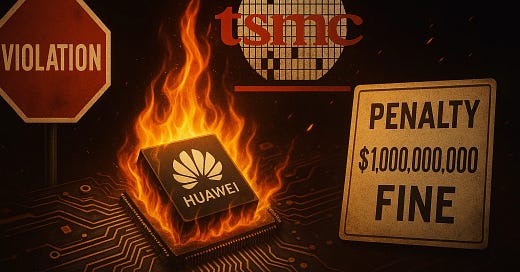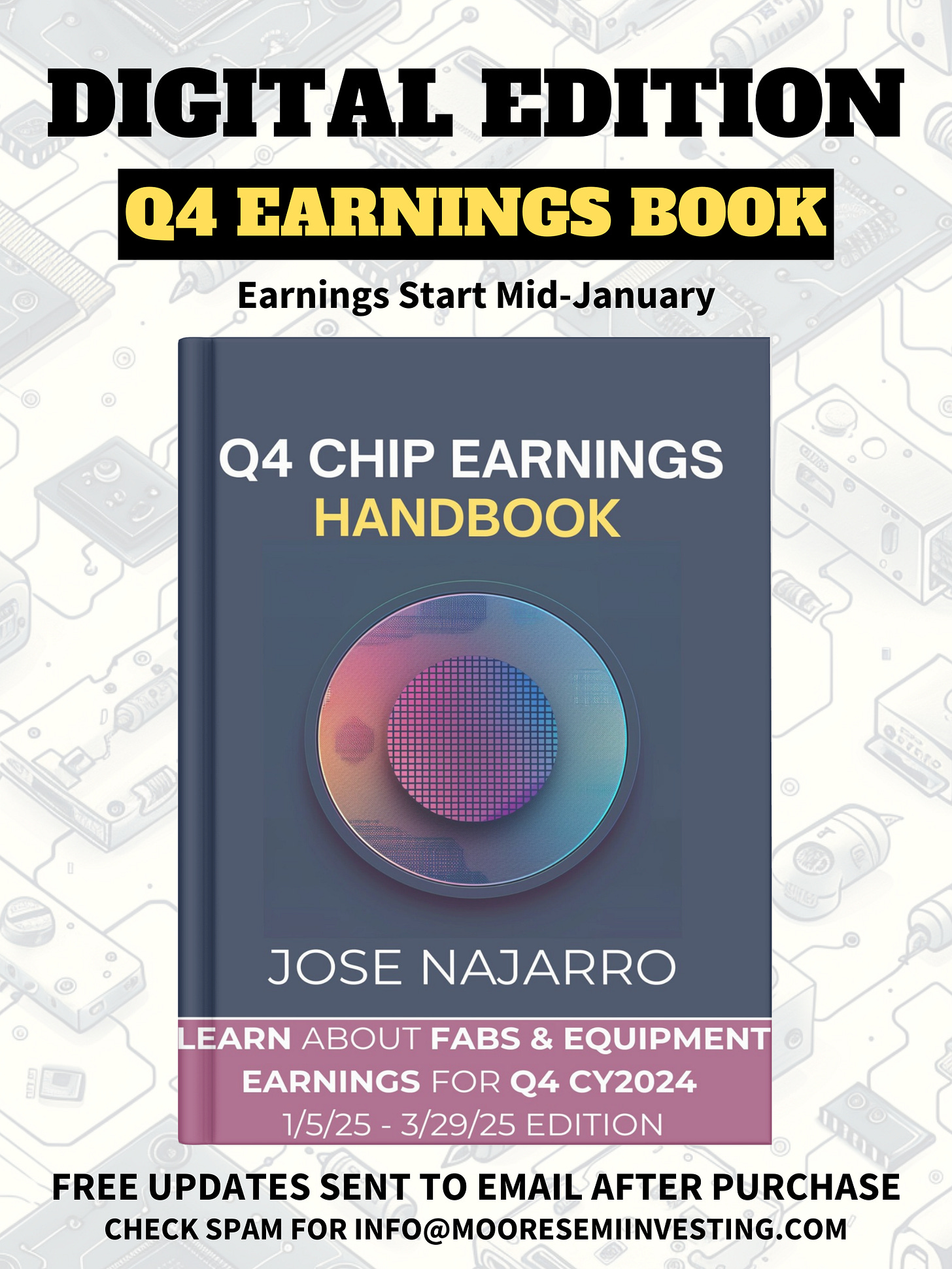⚠️ TSMC Faces Potential $1 Billion Fine for Export Violations Involving Huawei
Welcome, AI & Semiconductor Investors,
TSMC could face a colossal $1 billion fine for allegedly violating U.S. export controls by inadvertently supplying advanced chips to Huawei—highlighting critical regulatory risks that could reshape the semiconductor industry's landscape.
Plus, why AMD is feeling intense heat from rivals Nvidia and Intel, and discover how Aehr Test Systems is powering the next wave of AI semiconductor innovation. — Let’s Chip In
What The Chip Happened?
⚠️ TSMC Faces Potential $1 Billion Fine for Export Violations Involving Huawei
🚨 AMD Downgraded: Nvidia and Intel Intensify Pressure
🚀 Aehr Test Systems Powers Up AI Burn-In
[Aehr Test Systems Sees Revenue Growth and Expands Beyond Silicon Carbide]
Read time: 7 minutes
TSMC (NYSE: TSM)
⚠️ TSMC Faces Potential $1 Billion Fine for Export Violations Involving Huawei
What The Chip: TSMC could face a hefty fine exceeding $1 billion from U.S. authorities after reportedly breaking export control regulations. The Taiwanese semiconductor giant manufactured chips that ended up in Huawei’s sophisticated Ascend 910B AI processors, raising significant compliance and regulatory concerns early in 2025.
The Situation Explained:
🧐 The Main Issue: TSMC allegedly produced approximately three million chips designed by the Chinese firm Sophgo, which subsequently found their way into Huawei’s Ascend 910B AI system. Because TSMC's manufacturing equipment incorporates U.S. technology, these chips fall under strict American export control rules.
🔍 Discovery and Investigation: TechInsights, a Canadian research organization, uncovered a TSMC-produced chip inside Huawei’s AI accelerators, prompting the ongoing investigation by U.S. authorities.
💸 Significant Financial Impact: Under U.S. export control laws, TSMC may face penalties of up to twice the value of the violating transactions. Lennart Heim of the RAND Corporation estimates the fine could surpass $1 billion.
🚫 Immediate Actions Taken: In response, in early 2025, TSMC halted all shipments to Sophgo, and the U.S. Commerce Department mandated that TSMC stop exporting any 7nm or more advanced chips to China intended for AI applications.
📌 Trade Restrictions Expanded: After the investigation began, Sophgo joined Huawei on the U.S. restricted trade list in January, tightening trade limitations even further.
🌏 Broader Implications: The timing of this issue is sensitive, coinciding with increasing U.S.-Taiwan trade tensions and new tariffs. Although semiconductors are not currently impacted, TSMC’s expansive $100 billion investment plan in the U.S.—including five new fabs—adds complexity to the geopolitical backdrop.
💼 Financially Prepared: TSMC’s strong cash position, exceeding $70 billion in reserves and short-term investments, should enable the company to manage this financial blow.
Why AI/Semiconductor Investors Should Care: This incident highlights how strictly the U.S. is enforcing advanced chip export regulations, particularly when Huawei is involved. Investors should closely monitor how TSMC strengthens its compliance strategies and adjusts its supply chain. Continued strict enforcement could reshape global semiconductor dynamics, potentially impacting TSMC’s strategic choices despite its financial resilience.
Moore Semiconductor Investing
📗 [NEW!!] Unlock Q4 Semiconductor Earnings --- 60% OFF (NEW EARNINGS)
What The Chip: Get a front-row seat to the financials shaping the semiconductor industry. This continuously updated e-book by Jose Najarro distills the latest Q4 quarterly insights—from wafer production trends to AI chip breakthroughs—into a single comprehensive resource.
The Situation Explained:
🔵 Dynamic Updates: Start with giants like TSMC and ASML, then expand to 30+ companies as their Q4 2024 earnings roll in. Earnings are restarting!!
🔵 Broad Coverage: From traditional chipmakers to cutting-edge AI semiconductor players, get the full picture as it emerges.
Why AI/Semiconductor Investors Should Care: This evolving earnings handbook gives you a strategic edge. Understanding quarterly earnings data is crucial for gauging industry health, discovering new growth leaders, and aligning your investment approach with emerging technological waves.
Disclaimer: For educational and informational purposes only. Not financial advice. Consult with a qualified professional before making any investment decisions. Updates are only for the Quarter of Earnings.
Advanced Micro Devices (NASDAQ: AMD)
🚨 AMD Downgraded: Nvidia and Intel Intensify Pressure
What The Chip: AMD was downgraded on April 8th by KeyBanc Capital Markets due to rising competitive pressures from Nvidia and Intel, alongside growing uncertainty over potential U.S. export restrictions to China.
The Situation Explained:
🔻 Analyst Downgrade: John Vinh and his team at KeyBanc lowered AMD from Overweight to Sector Weight, though they kept a price target of $140—a potential upside of roughly +60% from current levels.
🌏 China Concerns: Analysts flagged the risk that new U.S. export controls could significantly impact AMD’s AI business in China, pointing out that growth in the AI GPU market outside of China is minimal for this year.
🚀 Nvidia Widens the Gap: Nvidia’s latest GB200 NVL exascale computing platform is pulling ahead, creating a significant performance advantage over AMD’s current offerings. It might take AMD considerable time to deliver a competitive response.
💸 Profitability Pressure: Analysts worry that Intel’s aggressive pricing could trigger a price war, compressing AMD’s margins and limiting its opportunities to capture further market share.
📉 Valuation Reality Check: Although AMD appears attractively valued at just 13x KeyBanc's 2026 earnings estimates, historical patterns suggest semiconductor stocks face challenges during periods of margin pressure.
⚔️ Intel Closing the Gap: Intel’s advanced 18A manufacturing technology may allow it to regain lost ground in both server and PC segments, making AMD’s recent market share gains tougher to maintain.
🛃 Tariff Troubles: While semiconductor components currently escape reciprocal tariffs, finished products like laptops don't. Intel’s robust production capabilities provide it with critical supply chain advantages in such a challenging tariff environment.
Why AI/Semiconductor Investors Should Care: This downgrade highlights the intense competition shaping the semiconductor industry. Nvidia’s continued advances in AI compute and Intel’s improved manufacturing capabilities could pose significant challenges to AMD’s near-term performance. Investors should closely monitor any AMD product announcements or shifts in U.S. trade policies that might alter the competitive landscape.
Aehr Test Systems (AEHR)
🚀 Aehr Test Systems Powers Up AI Burn-In
What The Chip: Aehr Test Systems just released its Q3 FY2025 financial results on April 8, reporting strong momentum in AI processor burn-in and diversification beyond silicon carbide. Management discussed multiple new customer wins, heightened demand for wafer-level burn-in solutions, and near-term tariff-related uncertainties affecting shipping and order timing.
The Situation Explained:
🔌 AI Wafer Burn-In Takes Off: Aehr’s new high-power FOX-XP system can handle up to nine 300mm AI processor wafers simultaneously, delivering thousands of amps per wafer while maintaining precise temperature control. “No other product on the market has the capability or capacity to test their wafers like our system,” said CEO Gayn Erickson.
🏗️ Expanding Market Reach: Beyond AI and silicon carbide, Aehr is ramping gallium nitride (GaN) power semiconductors for automotive and industrial use, shipping multiple FOX-XP systems to a “world-leading” GaN supplier. They are also seeing traction in hard disk drive head burn-in and silicon photonics.
🔩 Successful Integration of Incal Acquisition: Aehr's purchase of Incal Technology last year has significantly enhanced its offerings, particularly with high-power packaged part burn-in solutions like the Sonoma system. Shipments related to Incal in just the past nine months have already surpassed the entire three-year period prior to the acquisition.
📦 Navigating Tariff Challenges: Recent U.S. tariff announcements inject near-term uncertainty. Aehr is redirecting some supply chain steps, including drop-shipping parts to customer sites and leveraging international locations to minimize delays and extra costs.
💵 Financial Performance: Q3 revenues reached $18.3 million, up 142% year-over-year, fueled by ramping AI processor burn-in. Gross margin of ~43% came under some pressure from product mix and one-time ERP cost adjustments.
📌 Temporary Guidance Withdrawal: Management temporarily withdrew its FY2025 guidance, citing tariff-driven uncertainties in shipping schedules.
🗃️ Upcoming NAND Initiatives: Aehr is currently undertaking a proof-of-concept project with a leading flash memory supplier. This project aims to validate wafer-level burn-in processes for next-generation NAND flash memory, a segment management identifies as a potentially "substantial" market opportunity by 2027.
Why AI/Semiconductor Investors Should Care: Aehr’s unique wafer-level burn-in capabilities are poised to help solve reliability and yield challenges in advanced AI processors, compound semiconductors like GaN, and next-gen memory. As Erickson put it, “We’re excited about the significant progress we’ve made expanding into additional key markets.” Long term, these innovations could unlock substantial capital spending in test and burn-in equipment, especially as device complexity grows and reliability requirements intensify.
Youtube Channel - Jose Najarro Stocks
[NEW] Semiconductor Q4 Earnings Book — 60% OFF
X Account - @_Josenajarro
Disclaimer: This article is intended for educational and informational purposes only and should not be construed as investment advice. Always conduct your own research and consult with a qualified financial advisor before making any investment decisions.
The overview above provides key insights every investor should know, but subscribing to the premium tier unlocks deeper analysis to support your Semiconductor, AI, and Software journey. Behind the paywall, you’ll gain access to in-depth breakdowns of earnings reports, keynotes, and investor conferences across semiconductor, AI, and software companies. With multiple deep dives published weekly, it’s the ultimate resource for staying ahead in the market. Support the newsletter and elevate your investing expertise—subscribe today!
[Paid Subscribers] Aehr Test Systems Sees Revenue Growth and Expands Beyond Silicon Carbide
Date of Event: April 8, 2025 – Q3 2025 Earnings Conference
Executive Summary
*Reminder: We do not talk about valuations, just an analysis of the earnings/conferences
Aehr Test Systems, Inc. (“Aehr”) reported its fiscal third-quarter (Q3) 2025 earnings on April 8, 2025, highlighting year-over-year revenue growth, robust bookings, and a diversifying customer base. Traditionally known for its wafer-level burn-in (WLBI) solutions for silicon carbide (SiC) devices, Aehr is expanding into newer, high-growth segments such as artificial intelligence (AI) processors, gallium nitride (GaN) power semiconductors, data storage applications, and silicon photonics.
In Q3 2025, Aehr’s net revenue rose to $18.3 million, up from $7.6 million in Q3 2024. Non-GAAP net income reached $2.0 million, or $0.07 per diluted share—an improvement from a loss of $(0.9) million in the same period last year. Management attributed this performance to broader end-market penetration and early successes in AI processor burn-in, an area gaining momentum amid rising demand for data center acceleration solutions.
Notably, Aehr has diversified its revenue profile: whereas silicon carbide accounted for more than 90% of revenue in fiscal 2024, it contributed less than 40% in Q3 2025. Meanwhile, AI processors represented more than 35% of the company’s Q3 revenue. The quarter also included new multi-wafer test systems orders for gallium nitride and the first high-volume order for Aehr’s new application in hard disk drive components.
Despite these positive developments, Aehr Test Systems has withdrawn its formal revenue guidance for the remainder of fiscal 2025, citing near-term uncertainty from newly announced tariffs. Nonetheless, the company remains optimistic about long-term trends across AI, wide bandgap semiconductors (both SiC and GaN), emerging flash memory technologies, and silicon photonics.
Below is a concise overview of Aehr’s Q3 financial performance, commentary on growth opportunities, product and technology differentiators, headwinds, a financial deep dive, and the strategic outlook shared by management.
Growth Opportunities
Aehr Test Systems began as a key supplier of burn-in and test equipment for SiC power semiconductors, finding a natural market fit in automotive electrification. However, fiscal 2025 has marked a deliberate push into more diverse markets. According to management, such a pivot stems from:
AI Processor Burn-In
Wafer-Level Burn-In (WLBI): Aehr has qualified and shipped the world’s first WLBI systems specifically designed for AI processors. The flagship FOX-XP™ can burn in and test up to nine 300 mm wafers simultaneously, each wafer drawing up to 3,500 watts. This configuration is crucial because AI accelerators and high-performance computing (HPC) processors consume significantly more power than standard logic or memory devices. By detecting early device failures before packaging, customers can lower overall production costs and boost yields in these advanced chips.
Packaged Part Burn-In (PPBI): Aehr’s Sonoma system targets AI processors after they have been packaged. Multiple Sonoma systems shipped in Q3 2025 to a “world-leading hyperscaler,” who will conduct production-level screening to ensure reliability in large-scale data center rollouts.







